Emojis, Memes and Popular Lexicons: KUNSTRAUM’s Newest Exhibition Explores Modes of Communication

Located steps away from the Brooklyn Navy Yard, you can find KUNSTRAUM. Founded in 2015 by artist Nadja Verena Marcin and architect Fernando Schrupp, KUNSTRAUM emerged as a gallery space and artist hub to both support emerging art and foster interdisciplinary relationships between artists, curators, writers, filmmakers, and architects. KUNSTRAUM (derived from German, “kunst” translates to art and “raum” translates to room) pushes the parameters of emerging, international, contemporary art.
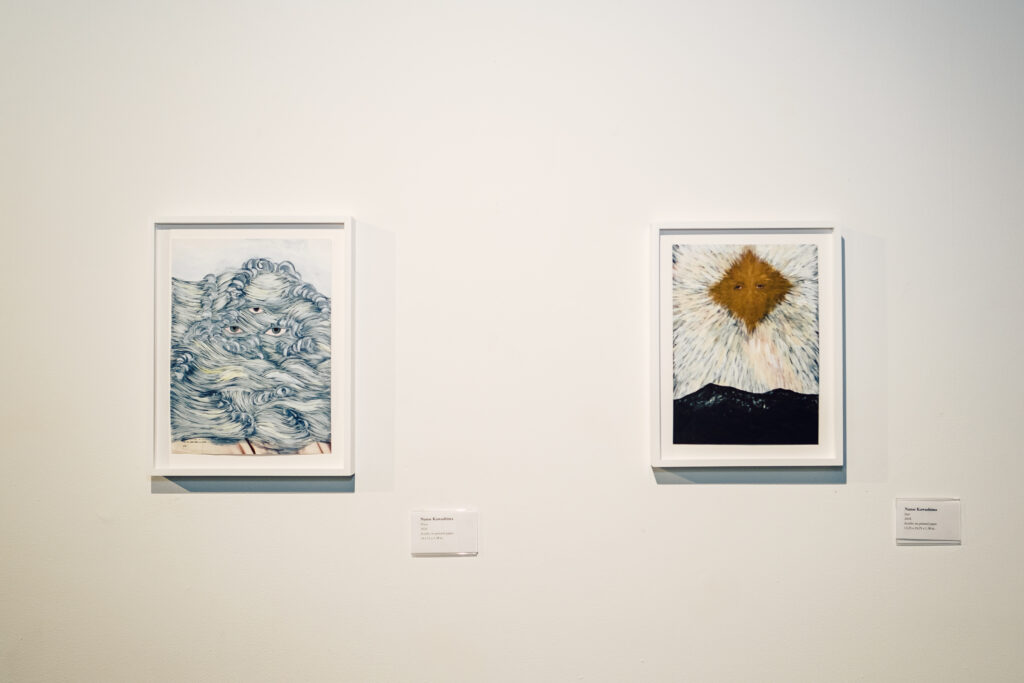
I had the pleasure of sitting down with Ashley Ouderkirk, the current Curator-in-Residence to discuss the newest exhibition Visual Implications. Spread across two different locations—Kunstraum’s main hub and the Chashama space on the Upper East Side—this exhibition explores how three specific artists dissect this dilemma of how our modes of communication are impacted by the internet, social media, and technology. Featuring works by Charles Clary, Nanse Kawashima, and Cassandra Zampini, each artist taps into the 21st century lexicon of selfies, memes, and catchy iconographic pop culture references. Many of us spend hours buried behind some type of screen, consciously (or unconsciously) so it’s no surprise that we take short cuts on the day-to-day by responding with a heart, a wink or even a quick like. As Ashley pointed out during our interview, “I believe images, since the dawn of the iphone, now share and at times eclipse the role of the written word in our understanding of the world. So, if we are getting a large portion of our information from images today, I wondered what our level of awareness was for ‘reading’ an image — how visually literate are the masses? What can we recognize easily, like pop culture references? Or what’s our level of understanding of traditional symbolism from religions and mythologies?”
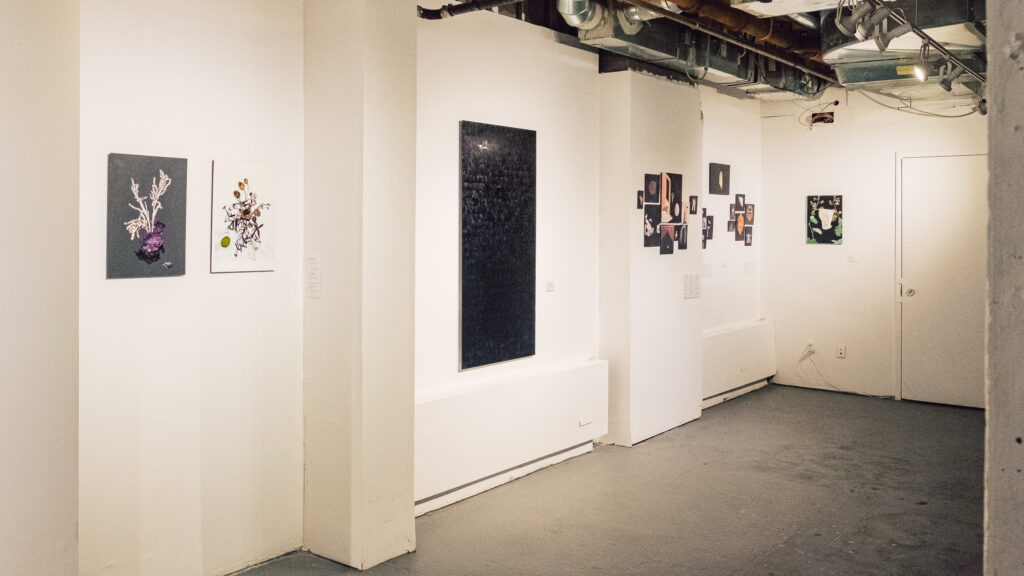
The new exhibition, Visual Implications, just opened last week. Visual Implications is spread across two different locations, and the exhibition explores pop-culture iconography, modes of communication and our reliance on technology. How did this exhibition come to fruition? What was the inspiration behind the exhibition’s name?
Ashley: As a curator, I’m always fascinated by not only how visitors see and interact with a work of art, but also how they “read” an image.
The original concept for this exhibition began with me thinking about the western history of visual literacy for another project. I was flipping through old textbooks and reading JSTOR articles on Ancient Roman and Medieval art, and stumbled upon a letter from a pope to one of his bishops in the early days of the catholic church. His letter advocated for religious art in the basilicas to remain, in a period when many in the church were destroying holy images. The pope’s reasoning was that because the congregation could not read the scriptures— as most were illiterate or perhaps banned from reading holy texts— they should be allowed to ‘read’ the pictures and connect to God’s lessons and morals that way. The Pope trusted the people’s ability to visually comprehend whereas the Bishop feared the potential dangers of miscommunications.
This dilemma felt very contemporary to me, and got me thinking about how images are used as forms of communication today. Our phones and personal devices have made communicating with images easier and at times preferable to the written word. How often do you reply to a text message with just an emoji or only click on a news story if you like the photo? I believe images, since the dawn of the iphone, now share and at times eclipse the role of the written word in our understanding of the world. So, if we are getting a large portion of our information from images today, I wondered what our level of awareness was for ‘reading’ an image — how visually literate are the masses? What can we recognize easily, like pop culture references? Or what’s our level of understanding of traditional symbolism from religions and mythologies? And are we capable of comprehending gestures, which may allow us to be more empathetic?
This exhibition presents those questions and shows how each of these artists incorporates these references into their works for the viewer to ‘read.’ The ‘implications’ part of the title refers to what are the consequences as individuals and society— both good and bad — for having poor visual literacy? Is visual literacy something we should value more?
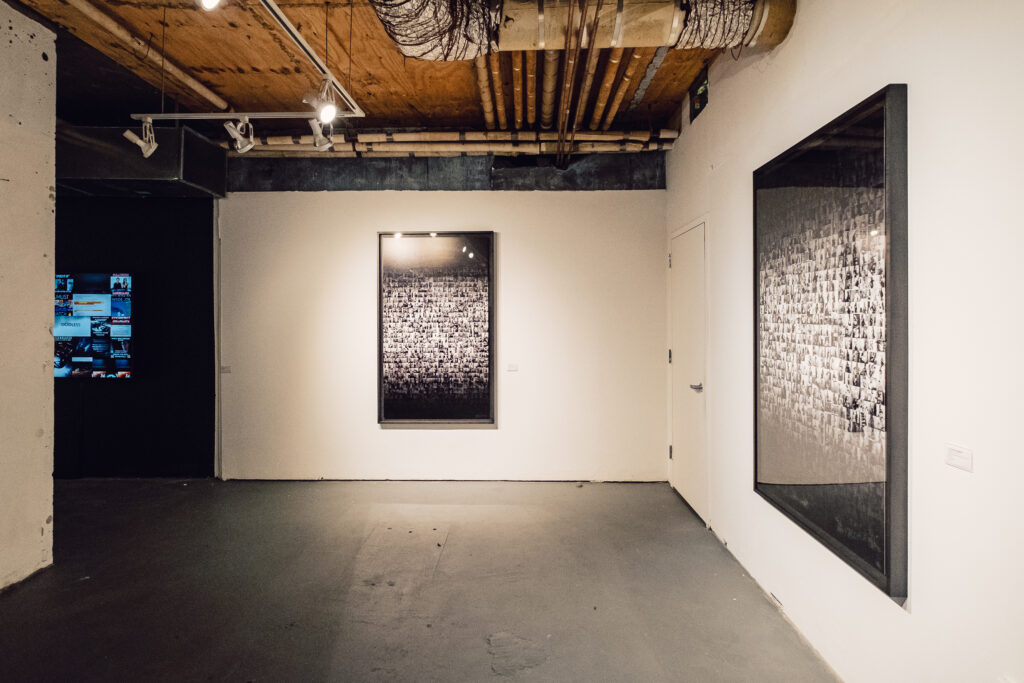
As the curator, what made you decide to have the exhibition exist in two different locations?
Ashley: In addition to having a more traditional group show in the Chashama space, I also wanted to have an immersive component, where I could work with one of the artists to create a custom installation. Having both a large-scale installation and group show in the same space would force both parts to unnecessarily compete. But by having them in separate locations they complement one another, and continue the conversation of visual literacy.
KUNSTRAUM’s gallery is perfect for this type of installation, as the narrow corridor-like spaces physically place the artworks into our personal space, encouraging intimacy. Inspired by 19th century Victorian era salons, the walls are painted a deep red currant and the artworks from Charles Clary’s Memento Morididle Movement series are hung floor to ceiling and closely spaced. Using this technique allows the individual works to ‘speak’ more clearly as a cohesive unit exploring the joys and pains of memory, while acknowledging memento mori to remind us of the ephemeral nature of both our current situations and lives. All 169 artworks are hand-carved paper sculptures placed within ornate salvaged frames. I like to think of the space as an invitation to walk-through the artist’s memory palace. Here he’s displayed an unedited version of his past, prominently revealing what’s beneath the surface.
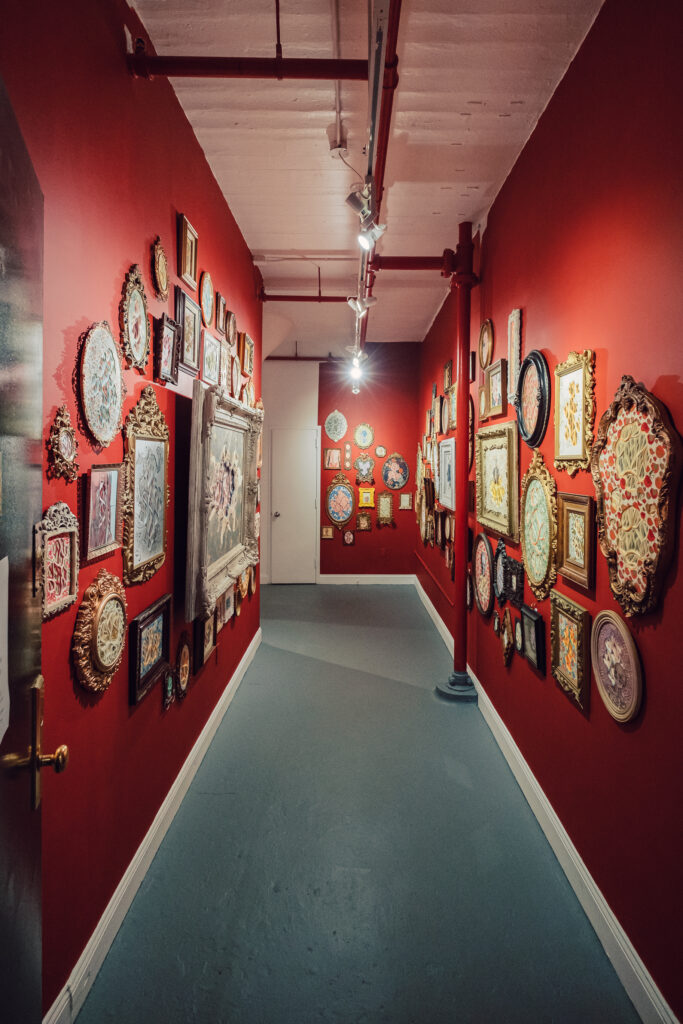
I’ll admit, I’m a token millennial who grew up watching VHS tapes and now spends many hours a day on Instagram. This exhibition evoked a hard sense of nostalgia and a reminder of how things have changed over the years in terms of technology, our modes of communication, things that used to be such a big thing (like Blockbuster and VHS tapes–Charles’ work really hit the nail on the head!). Did you have a demographic in mind for this particular show? What do you hope that viewers will take away from the show?
Ashley: Yes, I agree. Nostalgia is a strong draw for many people, and I must say as a millennial elder, Charles’s VHS series Be Kind Rewind also speaks to me personally. Visiting the video store was a weekend ritual in my family, and I remember my mom always wanting to arrive early enough to choose from the new releases. (To be sure, many of my favorite films are represented in the collection on view!)
What’s great is you can never predict what artwork people will connect with. For example many of the children who come in immediately walk over to Cassandra’s video MediaWarfare, and I’m guessing that may be because they’re most comfortable with screens. And many photographers seem drawn to Nanse’s work, perhaps because of her subtle incorporation of a photograph-base into her mixed media paintings.
As far as particular demographics, I always aim for my shows to be as inclusive as possible. I want everyone who walks into the gallery space to connect with one of the art objects, concepts or with the artist’s practice.
I think about people interacting with art on three distinct levels. The first is just visually being drawn in, and attracted to the artwork on an aesthetic level. The second is having your interest piqued enough to want to learn a bit more about what you’re seeing — a curiosity in the narrative, discovering how it was made, or wanting to learn what the work means. And the third level is having the work personally resonate with you — that as you’re viewing, learning about, and experiencing this work, it reflects something back towards you that you’re seeing or feeling in your own life, or perhaps it unearths this precious memory or even challenges a belief you hold dear. While I believe that any interaction with art is valid and important, as a curator I strive to make that third level connection with as many viewers as possible.
For Visual Implications as a whole, I hope viewers will start to question the impact of images as communication in their lives and consider expanding their visual literacy.
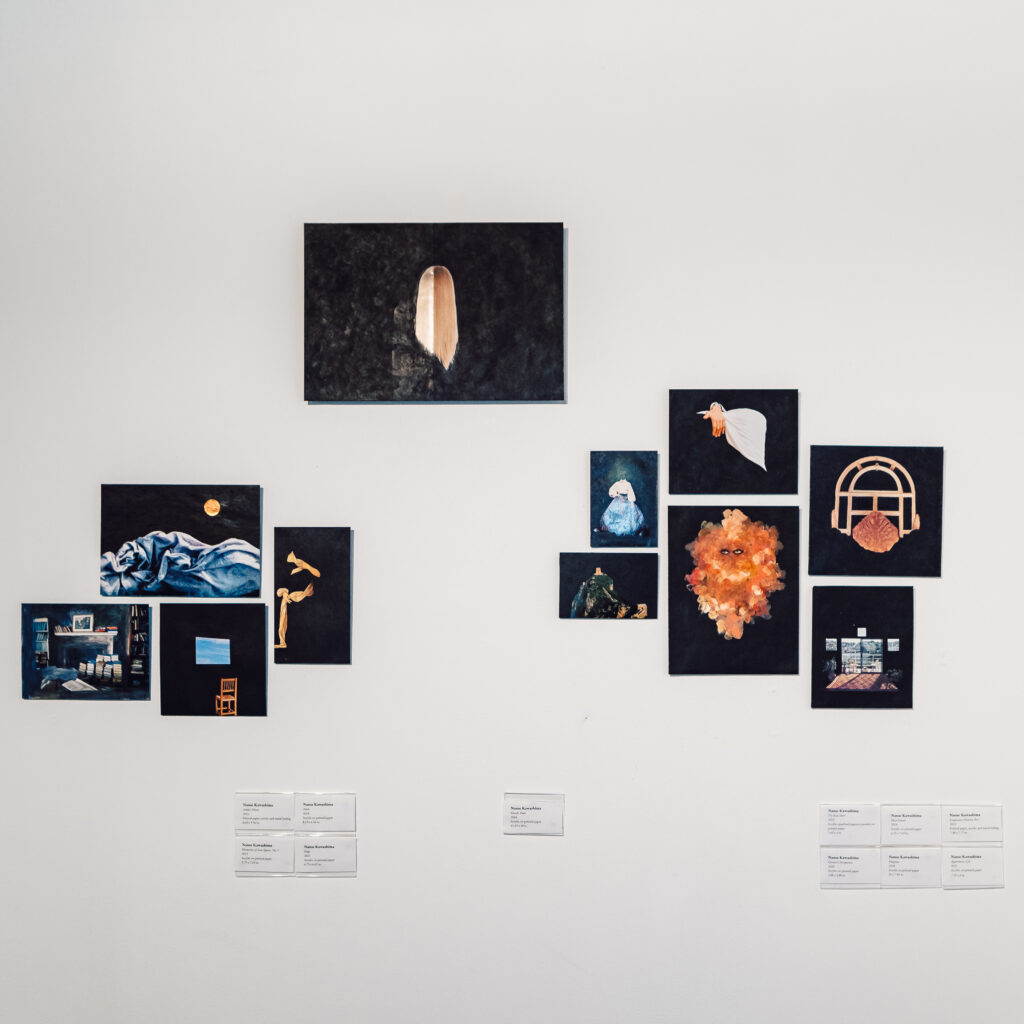
The three artists featured—Charles Clancy, Nanse Kawashima, and Cassandra Zampini —really work well together in this exhibition. Thematically, their work really complements one another. Were you familiar with their works before? How did you find the artists?
Ashley: Thank you, yes I’m an admirer of how each artist uses symbols, iconography, and gestures to communicate to the viewer, and how each artist accomplishes this in a very different way.
I’ve known each of the artists for a few years, but from very different groups.
I was introduced to Charles through the producer of fiance’s film. His husband works for SCAD in Savannah, and I saw a few of Charles’s larger pieces suspended in a window display. I love the sculptural aspect of his work, and I was instantly drawn to the way he excavates and reveals what’s beneath the surface. Each work felt so honest and freeing. I immediately started following him on Instagram and when I had this idea for a show reached out to him.
I met Nanse through this 125 collective of women artists (mostly self-taught) that a mutual friend of ours, Colleen Herman, began called the Sunday Salon. They (or we, as I now try to attend regularly) host regular artist salons in the style of Louise Bourgeois’s salons. Nanse had brought a few of her pieces to present, and I was instantly attracted to her use of black as calming and quiet. There’s a mysterious spirituality to her paintings that lures you in, and I just needed to know more and eventually did a studio visit with her. (And of course, Nanse’s Wave, has been the main image used to advertise the show.)
Cassandra, funny enough, actually hired me as a consultant to help her with writing didactic materials for an art fair. We found that we worked well together and have been collaborating ever since. I was initially attracted to her work because I loved how she could take something as ubiquitous as a ‘selfie’ and gently and beautifly reframe the conversation around them to encourage the viewer to think more deeply about the impact of technology in our lives. Cassandra was actually the one who told me to apply to the KUNSTRAUM curatorial residency program as she was applying to the artist residency program and even said, “wouldn’t it be funny if we both got in at the same time?” — and of course we did!
Switching gears a bit — for readers who might be interested in curatorial fellowships and/or artist residencies, where can they find that information?
Ashley: Of course! KUNSTRAUM hosts a trio of open calls each fall: one for the curatorial residence —which I’m currently participating in; the second for a three-month artist residency; and the third an open call for artworks that the curator in residence of the following year will organize. These opportunities are open to all artists and curators both local and international, and descriptions from our last open calls are on the website. The two best ways to stay in touch with our organization are by signing up for our mailing list and of course following us on Instagram @Kunstraumllc.
What else is coming down the pipeline?
Ashley: Next up is actually a curator tour of Visual Implications at the KUNSTRAUM gallery space on Sunday, Feb 12th at 4pm.
Then as soon as this show is deinstalled, I’m on a plane heading to Los Angeles to work the Felix Art Fair for one of my gallery clients, Luce Gallery, which is exciting. And I think my focus for the next few months (in addition to other art fairs) will be both writing more exhibition reviews and also expanding my artist consultancy. I now have the bandwidth to work with a few more emerging artists advising them on their career paths and helping them write about their work. As for curatorial projects, I have a few in the works, but I can’t announce them just yet. I will be sure to announce them on my website or instagram as soon as I can.
Visual Implications is on view through February 12th at both Chashama in Manhattan, and KUNSTRAUM Brooklyn. For appointments to see the show outside of public hours, please contact Ashley@kunstraumllc.com
Chashama, 340 E 64th Street, NY, NY. Hours: Thursday + Friday 3-8pm & Saturday + Sunday 10am-8pm, or by appointment
KUNSTRAUM LLC, 20 Grand Ave, Loft 509, Brooklyn, NY 11205. Hours: Saturdays 12pm-6pm or by appointment. Public Program: Curator Tour on Sunday, Feb 12 at 4pm, RSVP encouraged.
You Might Also Like
QWERTY, Flirty, & Crying: Four Internet Artists’ Take on Reality
Joiri Minaya and Nando Alvarez-Perez’s Sublime and Mysterious Grid
What's Your Reaction?
Alexandra Israel graduated from Bates College in 2010. A museum aficionado since her introduction to Jean Dominque Ingres' portraits as a small child, she enjoys spending her free time at museums and finding off-the-beaten-track gallery shows. Israel has been working in PR for over seven years, primarily within book publishing and in the art world. She has held positions at Penguin Book Group, Aperture Foundation, and Third Eye among others. l Instagram l

